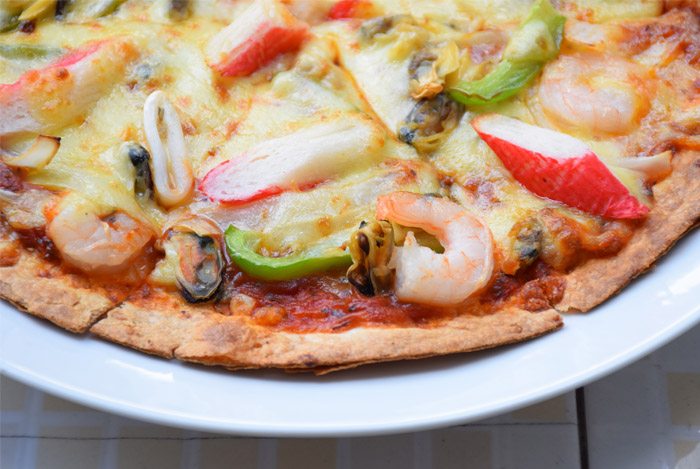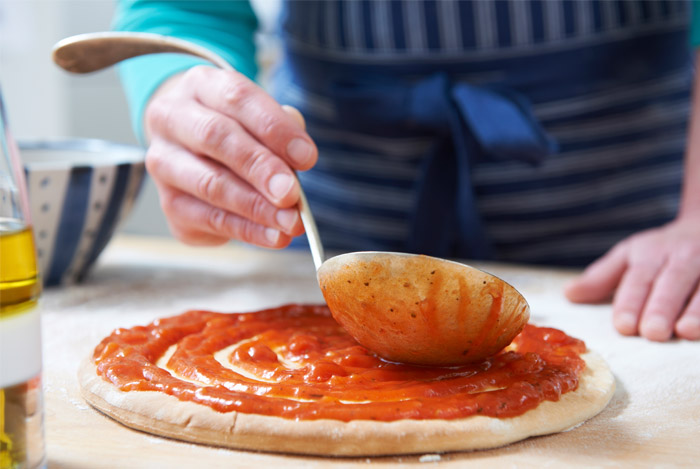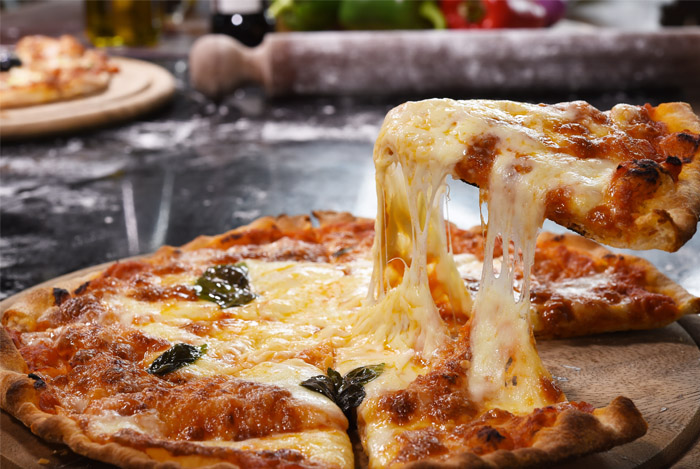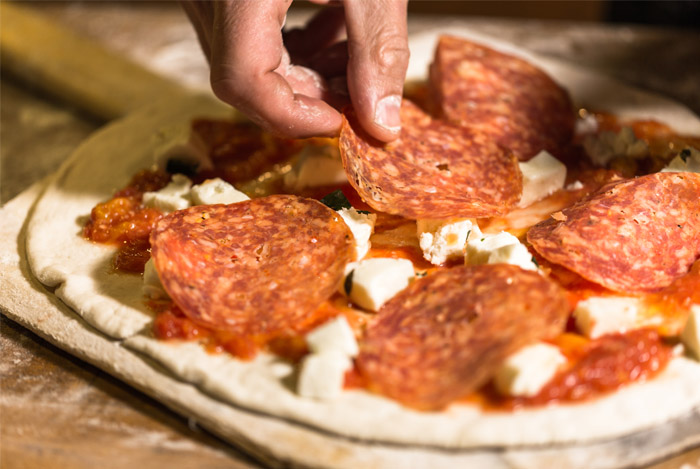Before learning about good nutrition, I ate so much pizza that I think half my brain is actually mozzarella.
Even though I’ve cut back my pizza intake, the average American consumes around 46 slices of pizza each year. That’s almost a slice per week!
I know you probably swore off pizza because it looks like a health disaster on the surface, but even I can admit that a crunchy homemade dough with warm, oozy cheese, and just the right amount of sauce is sort of intoxicating.
I’m getting hungry right now just thinking about it.
So while it may not be the healthiest meal, pizza has a few nutritious attributes hiding amidst all that cheese and deliciousness… but it also has a dark side.
Giuseppe Russolillo, president of the Spanish Association of Nutritionists, says:
“You have to bear in mind that while in the majority of Italy [pizza] is an artisanal product, in the US it is more related to ‘junk food‘.”
Junk food such as candy, soda, and the horrible ingredients used in fast food is usually high calories and very low in nutrients such as vitamins, fiber, or healthy fat.
Does pizza fall into this category, or can it be a nutritiously sound, complete meal?
While pizzas vary from mom-and-pop shops, big fast food-esque chains, and freezer versions you find at the grocery store, they all share similar ingredients.
So today we’re going to explore what those ingredients are really doing to your body.
That Warm Crispy Crust
 The second we bite into a slice of pizza, our brain is flooded with happiness thanks to the carbs in the crust.
The second we bite into a slice of pizza, our brain is flooded with happiness thanks to the carbs in the crust.
Eating carbs helps release serotonin, a neurotransmitter that makes us feel calm, relaxed, and in the mood for more carb-rich pizza.
Exactly how many carbs are we talking about here?
Let’s compare 14” pie crust options:
Thin: 230 calories; 21.8 g of carbs; 1.9 g of fiber
Regular: 285 calories; 33.2 g of carbs; 2.5 g of fiber
Thick: 312 calories; 35.6 g of carbs; 2.5 g of fiber
The Dietary Guidelines for Americans recommends making carbohydrates 45–65% of your total daily calories. So if you’re eating 2,000 calories a day, you should aim for 900–1,300 calories from carbs, which is between 225–325 grams of carbs per day.
One slice of regular crust pizza would account for roughly 10–15% of your day’s carbs.
However, if you’re going low carb on the Atkins Diet, you may only be allotting up to 100 grams of carbs each day; going Keto will restrict your carb intake even further to just 70–130 grams.
Now that one slice becomes 25–47% of your carbs for the day. That’s a pretty significant increase.
Even though low-carb diets are popular for weight loss and certainly help diabetics manage their blood sugar levels, carbs are not the enemy and cutting them out doesn’t automatically make you lose weight.
The trick to losing weight and staying healthy is choosing the right carbs, aka complex carbs, to make up the majority of your carb intake.
See, carbs are considered a macronutrient because our body needs them in relatively large amounts to help with everything from energy to memory.
Unfortunately, pizza is full of bad simple carbs made with overly processed white flour that’s digested quickly and doesn’t offer up much in the way of vitamins, fiber, or nutrients.
Once a simple carb hits your digestive tract, digestive enzymes quickly start to break it down into a usable form of energy, which we know as sugar.
It takes leptin — the hormone that’s responsible for signalling when you’re full so you can stop shoving pie in your piehole — close to 15–20 minutes to register that your cells have all the sugar they need.
This is why you need to portion control and eat slowly. Most people don’t eat one slice of pizza in 15–20 minutes, so they tend to overeat.
Your cells then become overwhelmed with sugar and start rejecting any more. This floods the excess sugar in your system to your bloodstream causing blood glucose levels to rise.
Now you’re forcing your pancreas to work harder to produce lots of insulin to round up all the wild sugar running around and put it to work as fuel for your body to use. Whatever doesn’t get used gets stored as fat by your overworked liver.
Eating refined grains has been linked to increased risk of abdominal fat, including the very serious visceral abdominal fat (aka belly fat), which raises your chances of developing type 2 diabetes, heart disease, and breast cancer.
Not to mention that high blood sugar also leads to inflammation that may cause heart disease and type 2 diabetes.
This is all no bueno.
You can see why the American Diabetes Association says that one serving of carbs is limited to 15 g. And a slice of pizza is double that serving!
So to healthify that slice of pizza, see if you can make or order a whole grain or whole wheat crust.
The slow-digesting complex carbs found in whole grains from unprocessed sources are nutrient-packed so you won’t experience the same blood sugar spikes that are common with digesting simple carbohydrates.
Hello, sustained energy and blood sugar levels throughout the day!
Plus, eating complex carbs improves:
- Digestion
- Metabolism
- Sleep
- Brain and nervous system functioning
- Satiety and weight loss
If you really want to be a healthy pizza-loving all-star, try making your own veggie-based crusts (yes, veggie!) at home. While cauliflower crusts most closely resemble actual pizza crust, you can also try making one with sweet potatoes for some extra nutritional benefits.
You can even get creative and top a slice of eggplant or fill a portobello mushroom cap with your favorite pizza sauce, cheese, and toppings to go ultra low carb.
Speaking of sauce…
It’s the Sauce that’s Boss
 That flavorful layer of tomato sauce is arguably the healthiest ingredient on your pizza.
That flavorful layer of tomato sauce is arguably the healthiest ingredient on your pizza.
Tomatoes are a rich source of antioxidants such as lycopene, beta-carotene, folate, potassium, vitamin C, flavonoids, and vitamin E.
“In Western countries, 85 percent of dietary lycopene can be attributed to the consumption of tomato-based products” like pizza sauce.
Lycopene specifically “may protect our immune cells from destructive free radicals, [or] molecules that can harm cells and damage DNA,” so we keep our defenses strong.
Now in order to enjoy the benefits of lycopene, you actually have to cook tomatoes or opt for tomato products such as tomato juice, sauce, and paste.
“Cooking tomatoes for two minutes, a quarter-hour, and a half-hour boosts the lycopene levels in tomatoes by 6, 17, and 35 percent, respectively,” according to research.
That means that even though one slice of raw tomato contains around 515 micrograms of lycopene, two tablespoons of tomato paste contains 13,800 micrograms of lycopene. That’s a staggering difference!
Two studies, one conducted on healthy participants and one studying type 2 diabetics, showed that consuming tomatoes and tomato products decreased levels of LDL, or “bad” cholesterol, and even reduced blood pressure levels.
Lycopene has also been linked to:
- Lower cholesterol
- Improved immune function
- Fewer blood clots
- Preventing artery hardening
- Decreased risk of stroke
See why you should be eating tomatoes every day?
Although it’s not all sunshine and rainbows; there are ways to make this stellar ingredient unhealthy.
Fast food pizzas and canned pizza sauces sometimes have crazy amounts of sugar or sodium. According to Prevention, some sauces hide “12 grams of sugar for every half cup,” which is equivalent to three sugar packets.
To make your own healthy sauce, start with pureed tomatoes that don’t contain salt or sugar. Add a dash of sea salt, oregano, and garlic, or mix your favorite herbs and spices for a unique pizza tailored to your tastebuds.
The best part about pizza sauce is that studies have found that those who follow a Mediterranean diet have lower risk of dying from heart disease because lycopene-rich tomato-based products are best absorbed by the body when paired with a bit of healthy fat such as olive oil…or cheese.
Cheese, Glorious Cheese
 I have a feeling most people love pizza because it’s a socially acceptable way of eating tons of gooey cheese in one sitting.
I have a feeling most people love pizza because it’s a socially acceptable way of eating tons of gooey cheese in one sitting.
The problem with cheese on pizza is that it falls into a gray territory; it’s not inherently horrible, but it’s not amazingly healthy either.
Cheese is a complete protein source so it contains all of your essential amino acids to help your body build muscle, repair tissues, and even supply a bit of energy.
A slice of cheese pizza will give you between 12–15 grams of protein.
The fats in cheese even slow down the digestion of the carbs and sugars in your pizza crust so they don’t hit your bloodstream too quickly.
When the fat gets broken down, it’s absorbed into your bloodstream so it can make its way over to your liver. Your liver will send over fat to your muscles if they need some energy. However, if your muscles have all the fat they need, it will be converted to deposits and stored (boo!).
This temporary elevation of triglycerides (or fat) in your blood will rise 45–60 minutes after you eat that slice, contributing to a state of elevated blood pressure that won’t return to normal until six hours later, per one slice of pizza.
If you eat more than one slice, are overweight, or have heart disease, your blood pressure will remain elevated longer, which increases your risk of heart attack and stroke.
Again, all of this gets worse the more pizza you eat, so moderation is key.
One slice of cheese pizza is 18.5 g of fat, or 28% of your daily value (DV) of fat. Break that down even further and you’ll see that one slice is comprised of 6.5 g saturated fat, making up 33% of your DV of saturated fat.
Saturated fat used to be villainized in the nutrition world, but recent studies have shown that “there is no significant evidence for concluding that dietary saturated fat is associated with an increased risk” of coronary heart disease, stroke, and cardiovascular disease.
This doesn’t mean you should order extra cheese on your pizza (don’t even think about it!), but natural sources of saturated fat such as nuts, coconuts, and olive oil are healthy.
Take the French Paradox for example.
French people have a relatively low incidence of coronary heart disease even though their diet is rich in saturated fats. Afterall, they eat the most cheese per capita of any other country.
According to one study, participants with the highest full-fat dairy consumption (median intake 339 g/day) had fewer deaths due to cardiovascular disease than those with the lowest intakes.
If you really want that cheese to work in a positive way, opt for cheese made from grass-fed cows.
Chuck Benbrook, research professor at Washington State University’s Center for Sustaining Agriculture and Natural Resources, says that organic, grass-fed dairy has 62% more healthy omega-3s than conventional milk.
“Pasture grasses and legumes provide milk cows with the building blocks for health-promoting omega-3 fatty acids, as well as the rich, earthy flavor in grass-fed whole milk,” Benbrook says.
Iwona Rudkowska, a researcher at the CHU de Québec Research Center, linked French Canadians’ dairy consumption with better metabolic health. Rudkowska believes that dairy’s fatty acids have health-promoting effects on metabolic health, including diabetes.
So to make your pizza healthier, ask for or make yours with half of the normal amount of cheese. This will give you a balance of the good parts of cheese without going overboard to the bad-fat dark side.
And always use grass-fed dairy to boost your omega-3 essential fatty acids, which your body needs to absorb from your diet as it can’t make them on its own.
Pizza Toppings 101
 Toppings are where you can turn a somewhat healthy meal into a nutritional wasteland.
Toppings are where you can turn a somewhat healthy meal into a nutritional wasteland.
The most commonly ordered topping for pizza is pepperoni.
We talked about why you should avoid processed meat like the plague, so I won’t go into all the gorey details again.
But know this: regularly eating processed meat has been linked to an increased risk of early death, especially from heart disease and cancer, due to all the excess salt, nitrites, and processing.
We eat an average of about 3,300 mg of sodium a day even though the Dietary Guidelines for Americans recommend limiting sodium to less than 2,300 mg per day if you’re under 50 and don’t suffer from hypertension or diabetes.
If you’re dealing with those conditions, are over 51, or African American, you should limit your sodium intake to just 1,500 mg per day.
A slice of cheese pizza contains 675 mg of sodium, or roughly 29% of your recommended salt for the day, but a slice of pepperoni pizza ups that number to 760 mg, or 33% of your DV.
Just for reference, foods having more than 480 mg of sodium (20% DV) are considered high sodium products.
Pizza is definitely salty, but adding saltier toppings only exacerbates the situation.
Avoid the mystery meat and choose high fiber veggie toppings such as:
- Spinach
- Kale
- Tomatoes
- Mushrooms
- Onions
- Peppers
These veggies will not only give you extra flavor and fiber, but they’ll supply you with vitamins and antioxidants that are severely lacking when you order a plain cheese pizza.
If you’re addicted to your pepperoni pizzas, find out why too much salt is killing you and learn how to follow a delicious low-sodium diet to knock that food addiction right out of you.
Final Thoughts
 We’ve talked about all the parts of the pizza, but what about the whole pie? Is it healthy or the worst food choice you can make?
We’ve talked about all the parts of the pizza, but what about the whole pie? Is it healthy or the worst food choice you can make?
As Ruben Bravo, a representative from the European Medical Institute of Obesity, remarks:
“The problem is not the pizza, it’s pizza abuse. It is a highly calorific food, but it is the same with a sandwich. We are talking about refined flours with fat that aren’t good for health.”
I say it all the time: moderation is the key to good health. Can you indulge in a slice of pizza every so often? Sure. Can you eat several slices every week? Absolutely not.
To make the healthiest pizza, you’re going to need to roll up your sleeves and get in the kitchen. Start with a whole grain or veggie-based pizza dough, top with low-sodium and low-sugar sauce, measure out a small serving of grass-fed dairy cheese, and pile on the healthy veggies.
If you need help, Cleveland Clinic has an awesome infographic about how to build your favorite healthy pizza.
And if you’re going to be lazy and order delivery, add (or make!) a big salad with lots of veggies to satisfy your hunger and keep you from eating more than one slice.
How do you make your favorite pizza? I like adding fresh basil and tomato, but I’ve been known to partake in a Hawaiian pie once in a blue moon 😉 Share your best pizzas with me— I’d love to hear about them!
The post What Eating Pizza Really Does To Your Body appeared first on Nutrition Secrets.
http://www.nutritionsecrets.com/what-eating-pizza-really-does-to-your-body/
No comments:
Post a Comment